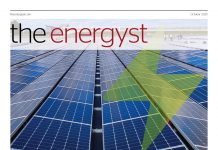Metered energy efficiency could unlock the holy grail of a market-based approach to cutting carbon, pulling in financiers, cutting the need for network investment and unlocking new business models. Brendan Coyne reports
A UK-US partnership is attempting to embed a standardised, automated approach to real-time energy efficiency measurement into the GB energy system.
The firms involved believe it will enable an energy efficiency (EE) market that can help decarbonise the economy, reduce network investment and enable new business models based on actual data rather than calculations carried out to varying standards. They also think it could bring energy efficiency into grid balancing.
EnergyPro is currently in talks with the UK government about using an open-source software platform to help deliver the next phase of the Energy Company Obligation (Eco). Developed by Open Energy Efficiency (OpenEE) in the US, the software and the models it enables are starting to bear fruit in California, where it is being used to enable pay-for-performance energy efficiency projects and defer grid infrastructure investment.

According to EnergyPro’s Alex Rathmell: “Metered energy efficiency is a standardised and automated way of ‘measuring’ energy savings in real time so they can be valued alongside other time and location-specific resources, such as demand-side response.”
While energy efficiency can’t actually be measured, Rathmell says energy use via real-time (or at least frequent) meter readings as enabled by smart meters can be metered. That means energy savings can be calculated against a counterfactual baseline.
Traditional measurement and verification (M&V) has long used that approach, usually for large building projects. Engineers use global standards to make a calculation – but how the calculation is carried out can lead to inaccuracies around the true savings.
OpenEE and EnergyPro believe a software-driven approach using smart meter data will deliver a more accurate picture – particularly for calculating the impact of aggregated domestic and small business energy efficiency measures.
Rathmell explains in a recent white paper: “The software takes meter readings, other inputs such as the local temperature conditions and uses a fixed, transparent, open source methodology to calculate savings, or avoided energy use (sometimes known as ‘negawatts’ or more correctly ‘negawatt-hours’.)
If the meter readings provided are live, such as half-hourly smart meter readings, the savings calculations are live too,” he states.
“When this approach is taken across a portfolio of home retrofit projects, it gives a highly accurate evaluation of the true, weather-normalised savings achieved by an energy efficiency programme. In any portfolio, some projects will exceed expected performance while others will under-perform, but in a properly targeted programme these effects balance out.
“This means savings can be measured for a tiny fraction of the marginal cost of using a consulting engineer to carry out the same analysis, making the approach viable for smaller sites such as individual homes.”
OpenEE is using that approach in the US, particularly California, to enable new ways of structuring incentives and markets – and in some cases, leading utilities to defer investment in infrastructure (see boxout below).
The companies believe a standardised approach based on metered data also derisks energy efficiency for consumers, investors and governments implementing energy efficiency programmes.
The software
The software underpinning the approach is called Caltrack (see caltrack.org).
“It’s an open source methodology for taking simple inputs from a building – energy use from the meter, temperature data and information about an energy efficiency intervention carried out in that building – and turning that into an energy saving,” Rathmell explains. “You are calculating the value of that intervention for that building based on metered data rather than, say, an SAP model, thereby moving into proper measured data.”
The approach would not be suitable for large, complex Esco projects, “but at a household level, it is proven,” says Rathmell. “Aggregated across a portfolio of households you get a really accurate picture of the savings that have been achieved – and that is a powerful concept.”
Flexibility from EE
With accurate data and real-time locational measurement, energy efficiency “moves from static to dynamic”, Rathmell suggests.
“It puts energy efficiency at the table with demand-side response, storage and all the other flexible technologies being talked about. It gives EE a seat at that table by enabling a time and location-specific resource rather than something that is modelled a year later that doesn’t really reflect actual performance.”
However, Caltrack was developed for the Californian market. The task facing Rathmell and EnergyPro is to find a suitable UK entry point. Their initial thinking is that distribution network operators (DNOs) might provide that opening – or potentially, energy suppliers.
“The software is open source. You can download the source code and statement of methodology from the OpenEE website – so we are not trying to create a cottage industry around its deployment as a product,” says Rathmell.
“Our revenue model is likely to be enterprise integration into DNO systems, but that’s in the future.” For now, he says, it is all about getting concept out there. “The best way to do that is to deploy it in real projects – albeit those that don’t yet use price signals and pay for performance models we will ultimately be using.”
Which is where suppliers come in.
Eco push
Under the Energy Company Obligation (Eco), suppliers are mandated to deploy energy efficiency measures to help less well off customers. The next phase of Eco (Eco 3) is under development and Rathmell thinks it could prove a fertile test ground for metered energy efficiency while providing benefits for suppliers – and ultimately bill payers that pick up the tab.
“There will be a mechanism in Eco 3 to use in situ measurement – and if you can demonstrate your measures outperform the need, you qualify for extra credit to meet your obligations,” Rathmell explains. “That is quite attractive to suppliers.”
To prepare the groundwork, EnergyPro has conducted a “tentative” pilot with Beis using data from the National Energy Efficiency Database, creating a virtual dashboard to illustrate how a live iteration would function.
“You can see how contractors are preforming, how measures are performing against predicted savings and against other interventions; a whole suite of tools versus manual spreadsheets,” says Rathmell. “But the real opportunity comes when Eco 3 goes live and, hopefully, we can deploy it.”
Network innovation collaborators?
Network Innovation Competitions (NIC) – where energy networks are awarded funds by Ofgem to develop smarter ways of running their networks – are also on EnergyPro’s radar. The company hopes to become part of a consortium bidding for NIC funds, says Rathmell, and recently pitched its ideas at the Energy Networks Association’s NIC conference.
“Putting programmes like Eco and NIC projects onto the same measurement platform would be very powerful, because it allows the energy system to properly value energy efficiency interventions and account for them in terms of management and delivery,” he says.
With support from the Energy Systems Catapult, the company hopes to find “innovative business model providers to see if we can collaborate on technologies that might be useful for DNOs,” says Rathmell.
“If we can provide the evaluation tool, we can be part of those projects. So we are very keen to hear from people in that area with a view to collaborating on one or more innovation projects.”
Energy efficiency 2.0: Unlocking new business models

OpenEE chief executive, Matt Golden, is one of the driving forces behind metered energy efficiency. He thinks it will provide the building blocks to commodification.
“You can’t trade kilowatt hours without a standard understanding of what that is,” he tells The Energyst.
“A market requires weights and measures, an agreement about what you are trading. That is what we do: a standard, open source platform that uses data from smart meters to measure how energy events impact demand at the meter on a time and locational basis,” he says. “And that has not existed before.”
The code “has been tested on 50 million meters and anyone can use it without restrictions”, says Golden. “They can see every line of the code, there are no secrets. That is key.”
Pay for performance
If everybody uses the same metrics for calculating savings, and the ‘market’ is updated in real time (via smart meters), new business models will follow.
“Efficiency is really weird, it’s one of the only things where we pay people in advance based on an engineering estimate,” he suggests. That legacy approach leads to perverse outcomes.
“If I am a contractor and you pay in advance, I have no incentive to do high-quality work. But pay for performance aligns those incentives.” Moreover, pay for performance “shifts the risk from the rate- or bill payer and onto the private sector”, says Golden.
“All of a sudden, companies are taking the risk, so regulators don’t have to micromanage every step. You enable innovation and competition,” he says. “You only pay for outcomes, and let the best solutions win.”
EE versus infrastructure
Reliable data and standard methods for calculating the impact make energy efficiency bankable, says Golden. Tie in time and locational impact “and you can quantify the savings by hour and the impact on load shape”.
He thinks that is a game changer.
“If you know when and where efficiency is happening, you can put EE into the same procurement bucket as other distributed energy resources. You can trade in the same way and treat it as a resource to support the onboarding of renewables or use it as a replacement for ageing infrastructure,” Golden suggests.
“Instead of paying for estimates in advance we are now competing with the marginal cost of the alternatives such as batteries,” he says. “And [on that basis] we are finding that EE is plentiful and a good deal.”
Californian utility PG&E has taken note. The firm has launched a rebate scheme that will pay aggregators of energy efficiency up to $20m based on actual metered results. The utility will calculate efficiency using the open-source Caltrack methods.
This article was first published in the October/November print issue of The Energyst. You can flick through the issue here.
If you have some responsibility for energy within your organisation, you can subscribe for free, here.
Related articles:
Local authorities plan £100m energy fund
Prepare for impact: How IFRS 16 will affect energy performance contracts
Enforce energy efficiency and make decent EPCs mandatory, big firms tell government
Bring public sector into Esos and hold directors to account
Policymakers must unlock economic benefits of storage, flexibility and efficiency
Investor confidence project seeks heat network and street lighting projects
MEEF: £500m more beef for energy efficiency funding
£185m available for SME energy efficiency projects
Dead money: use dormant bank accounts to help councils fund clean energy, MPs urge
Standardisation the key to growing energy efficiency money markets
Click here to see if you qualify for a free subscription to the print magazine, or to renew.
Follow us at @EnergystMedia. For regular bulletins, sign up for the free newsletter.



